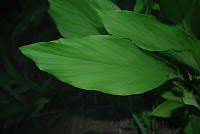 I continually strive to improve the quality of the vegetables produced at the farm. The basic principle is "going organic". What this means to me is that no chemical pesticides or fertilizers are used and the water source is free from "introduced chemicals". From my experiments, it all starts with good quality seeds and importantly, good quality soil.
I continually strive to improve the quality of the vegetables produced at the farm. The basic principle is "going organic". What this means to me is that no chemical pesticides or fertilizers are used and the water source is free from "introduced chemicals". From my experiments, it all starts with good quality seeds and importantly, good quality soil.I experimented with different types of organic matter mixed with the soil. As long as it is organic, I am game to try with some exceptions. I have used goat manure, cow manure, decomposed vegetation as well as commercially produced organic soil mixture. To me, it is important what you add to the soil in order to have a good produce in the end.
The current round of vegetables that I am planting have at least 50% organic matter in the soil and I find that it works very well. It keeps the soil moist and not soggy and allows for good aeration as well as drainage. For leafy vegetables, I plant them in polybags and keep them in my greenhouse to help reduce attacks by pests. I will continue to add more organic matter and organic fertilizer as the plants grow with the frequency dependent on the type of vegetable. I also seed other types of vegetables like baby cucumber, French beans, long green beans, tomatoes and various others with this highly organic soil mixture. This helps produce healthy "baby plants" before they are transplanted outside with the exception of tomatoes which I keep in the greenhouse. The main reason why the tomatoes remain in the greenhouse is because the chickens love the ripe tomatoes and would fly up to the fruits and peck at them!
By electing to go organic, I spray my vegetables with serai wangi juice which serves as a deterrent but I do have to do some manual tasks like manually removing the slugs and caterpillars as well as spraying them with water to reduce the "white flies".
I like to eat most of my vegetables raw so keeping it free from chemical pesticides removes the worry of ingesting harmful chemicals. To me, washing the vegetables may remove most of these chemicals but some will still remain within the vegetable itself as well as on the surface. The weirdest advise I have ever received was, in order to remove the chemical pesticides, to clean the vegetables with a mixture of water and Clorox!
After I harvest the vegetables, I will "process" the soil by mixing it with more organic matter before re-using it to plant more vegetables. I love it when I encounter earthworms as these are among soil's natural best friends.











.JPG)

.jpg)








.JPG)


























